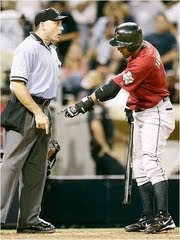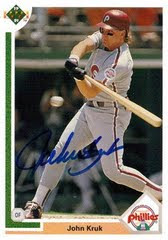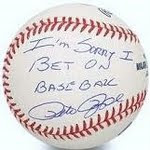With Cliff Lee's recent injury (and five game suspension) and Erik Bedard's checkered injury past, the Mariners are rumored to be looking to add a starter. MLB Trade Rumors mentions a few names that may be available: Nate Robertson, Brian Tallet, and Manny Para. Of them and the available free agents (including Washburn and Pedro), Parra seems to be the most interesting name.
A 6'3" Lefty with a low 90s fastball and three other pitches, Parra was drafted in the 26th round of the 2001 baseball draft by the Milwaukee Brewers. Through his first 200 innings of play between A, AA and AAA ball over 2006 and 2007, Parra toyed with minor league hitters, posting a K/9 of 8.33 or higher at each level and a BB/9 under 3 at AA and AAA. Parra also kept the ball on the ground well, posting HR/9 rates below 0.40 once promoted to double A.
Parra got his first taste of the majors in late 2007. There, he flashed an 8.89 K/9 over a minute 26.1 IP sample size, but it came paired with a then-uncharacteristic 4.10 BB/9 and a 32.9% GB rate. Due to some Clayton Kershaw-like luck (3.1% HR/FB), Parra managed to keep his numbers respectable (3.76 ERA, 4.52 xFIP).
Parra nabbed a full time gig in 2008, pitching 166 major league innings with a slightly above average 4.39 ERA. Though Parra's wildness remained high (4.07 BB/9) and his strikeouts tumbled some (7.97 K/9), his groundball rate soared past the 50% mark (51.6% GB rate, 1.94 GB/FB ratio). This led to a 3.85 xFIP and the promise of future success; especially if Parra could trim down the walk rate (which his minor league numbers indicated was reasonable).
Parra entered 2009 as a sleeper on many draft lists, including my own. He profiled similarly to Ubaldo Jimenez: big strikeouts, lots of groundballs and pretty wild. However, whereas Ubaldo was being drafted much higher and whereas Ubaldo had never had any semblance of control entering 2009, Parra at least had AA and AAA numbers to back up a reasonable expectation of less free passes in 2009. Of course, as any 2009 Parra owner could tell you, it just was not destined to be.
Parra's walk rate soared in 2009, jumping up to 4.95 per nine. While the groudball rate was still promising (48.1%), hitters were making more contact with his pitches and the strikeout rate fell a tad more (7.46 K/9). Despite throwing less than 150 innings in 2009, Parra was 15th in total walks issued on the season (Brewers fans should note that the #1 and #3 pitchers on the list of who issued the most walks in 2009 were Doug Davis and Yovani Gallardo).
Parra is slated to begin the 2010 season in Triple-A Nashville. Like several other pitchers, Parra has loads of potential being hindered by lack of command and he's running out of options. What would happen if the Mariners were to acquire him?
Let's use 161 IP as the baseline, approximately how many innings the average fifth starter can expect to accumulate over the course of a season (and also of which will give us nice numbers to use in the analysis). Using Manny Parra's career numbers (7.83 K/9, 4.44 BB/9, 48.7% GB%), he profiles as a 4.23 xFIP pitcher. In moving from the AL to the NL, The Hardball Times found that, on average, a pitcher's K/9 rate would rise by 0.57 per nine and that their ERA would fall by 0.41 runs. Accounting for these factors, Parra would have a prospective 4.64 ERA and 7.26 K/9. Over 161 innings, that would result in 83 runs allowed.
Next, we need to accord for park factors. According to Baseball Reference's multi-year park data, Safe Co. Field has suppressed offense by 4%. This would bring Parra's 83 runs allowed total down to to 79.68.
Finally, we need to account for defense. Last season, the Mariners had the absolute best defense in baseball, worth +1.5 WAR compared to the next best fielding team (the Rays). In 2010, the team looks about the same with the subtraction of Adrian Beltre (+14.3 FRAR) and addition of Chone Figgins (projected +6.5 FRAR). If we hold the rest of the team's defense constant (you can adjust this if you think the Mariners will be better/worse defensively in 2010 compared to 2009), the team would prevent +0.53 runs per inning compared to the league average defense. In other words, over 161 innings, the Mariners defense alone would prevent 8.56 runs.
Subtract this from Parra's league and park adjusted runs allowed total and we get 71.12 runs allowed with a 7.26 K/9. Over 161 innings, Parra would then post a 4.00 ERA with 130 K's to boot. Not too shabby for a 5th starter. Just imagine what would happen if he cut down the Edwin Jackson-like walk rate.
Showing posts with label Real Baseball Analysis. Show all posts
Showing posts with label Real Baseball Analysis. Show all posts
I Want Boof Bonser (Cubs Edition)
Posted by
David "MVP" Eckstein
on Friday, March 19, 2010
 As a Cubs fan, the fragile nature of the team's 2010 rotation (especially given the slew of injuries that plagued the team in 2009), worries me. With the departure of Harden and with Lilly's injury, I am concerned about what to expect from what used to be one of the NL's top rotations. I do not want to see Jeff Samardzija or Carlos Silva spot starting or, god forbid, being handed a rotation slot. Gorzelanny showed significant improvements in his strikeout and walk rates in both the majors and minors last season, so there is reason for optimism with him in the #5 spot of the rotation. However, there is no legitimate reason for the Cubs to gamble on him as being anything but a serviceable fifth starter; at least not if they want a legitimate shot at winning the NL central in 2010. This means Marshall will probably have to spend sometime in the rotation, leaving an already thin bullpen even thinner.
As a Cubs fan, the fragile nature of the team's 2010 rotation (especially given the slew of injuries that plagued the team in 2009), worries me. With the departure of Harden and with Lilly's injury, I am concerned about what to expect from what used to be one of the NL's top rotations. I do not want to see Jeff Samardzija or Carlos Silva spot starting or, god forbid, being handed a rotation slot. Gorzelanny showed significant improvements in his strikeout and walk rates in both the majors and minors last season, so there is reason for optimism with him in the #5 spot of the rotation. However, there is no legitimate reason for the Cubs to gamble on him as being anything but a serviceable fifth starter; at least not if they want a legitimate shot at winning the NL central in 2010. This means Marshall will probably have to spend sometime in the rotation, leaving an already thin bullpen even thinner.Given the overall lack of quality pitching depth on the team at the moment, I propose the following and most likely controversial solution: acquiring Boof Bonser from the Red Sox. Bonser, who has a career 5.12 ERA and 1.45 WHIP in 391.2 IP, is out of options and unlikely to break camp with the Red Sox. Thus, he would have to clear waivers to be optioned down the minors. The likelihood that he will be either traded or essentially given away in a waiver claim, therefore, is high. The Cubs should pounce on the opportunity, should it arrive. Here's why.
Despite the horrendous results, Boof Bonser has not been a horrendous pitcher. While playing in the AL (granted, the AL Central), Bonser has accumulated a career 7.28 K/9 and a strong 2.87 BB/9 with a 40+% GB rate to boot -- sure signs of potential. The reason for the poor ERA and WHIP seem to be poor luck. His career BABIP is .326 (league average was .304 last season); his LOB% in 2007 and 2008 were 69.6% and 57.9%, despite the league average being 70.7% and 71.4%, respectively. Furthermore, Bonser has a career HR/9 rate of 1.40, despite a career GB rate of 42.9% (resulting in an unlucky 12.3% career HR/FB rate). Despite all of his struggles in the major leagues, Bonser's career xFIP is a promising and significantly less ugly 4.30 mark. A 4.30 xFIP isn't exactly going to light the world on fire, but it shows that he has not been the complete disaster his ERA says he's been. It is worth noting that Bonser's sample size is very limited and many people forget that he has the pedigree for success (first round pick in 2000; he was the intended centerpiece of the A.J. Pierzynski deal between the Giants and Twins in 2003).
In figuring out what Bonser could provide the Cubs, I am going to utilize his career 4.30 xFIP and 7.28 K/9 as the baseline for this analysis, which is actually a bit pessimistic, in my opinion. Given that he is recovering from rotator cuff and labrum surgeries which forced him to miss the 2009 season, let's limit his innings threshold to 100.
In moving from the AL to the NL, The Hardball Times found that, on average, a pitcher's K/9 rate would rise by 0.57 per nine and that their ERA would fall by 0.41 runs. Accounting for these factors, Bonser would have a prospective 3.89 ERA and 7.85 K/9. Over 100 IP, that would be 43.22 runs allowed.
Next, we account for a change in park. Through the 2008 season (Bonser's last year of play), the Metrodome suppressed run scoring by 4%, whereas at Wrigley through last season, the park exaggerated run scoring by 8%. This 12% swing would inflate Bonser's runs allowed to 48.63.
Finally, we need to accord for defense. Last season, the Cubs allowed 19.8 runs to score compared to the league average defensive posture. Stated otherwise, the Cubs had allowed -19.8 Fielding Runs Above Replacement (FRAR). However, out goes Milton Bradley (-4.1 FRAR), Jake Fox (-6.7 FRAR), Aaron Miles (-2.7 FRAR), Joey Gathright (-0.9 FRAR), and Reed Johnson (-1.2 FRAR) and in comes Marlon Byrd (-1.0 FRAR), while Alfonso Soriano (-10.8 FRAR last season) has a 3-year UZR/150 in the OF of +5.8 (let's just say his FRAR in 2010 is completely neutral, though CHONE pegs it to be positive). In theory, that is a +25.4 FRAR swing in the right direction; a rough +5.8 team FRAR projection for 2010. Last season, the average team played 1442 innings of defense, so the Cubs would be preventing a mere +.004 runs per inning played compared to the league average defense. Over 100 innings, this would essentially save Boof Bonser just under one-half of a run, bringing his projected 2010 runs allowed total on the Chicago Cubs to 48.22.
In my estimation, therefore, over 100 IP, Bonser would post an ERA of 4.34 with 87 or so strikeouts. Given an expected (and sharp) regression in BABIP, I would expect the WHIP to tumble to the 1.35 or so range. Bill James says 1.38.
Could be worse, right?
But that's not necessarily the reason why I want the Cubs to acquire Bonser. Despite the lack of starting pitching depth, it's the lack of bullpen depth that scares me more. According to Tom Tango his publication The Book, the difference between a pitcher's ERA as a starter versus a reliever is about one run. If true, this would make Boof Bonser a sub-4 ERA relief pitcher who strikes out his share of guys, keeps the ball on the ground at a respectable rate, and does not walk too many batters. Given the state of the Cubs bullpen -- many high walk, flyball pitchers -- Bonser could prove to be a valuable asset for the team at a low price. Given the loss of Guzman and the price tag of Jason Frasor, I say the Cubs consider it.






